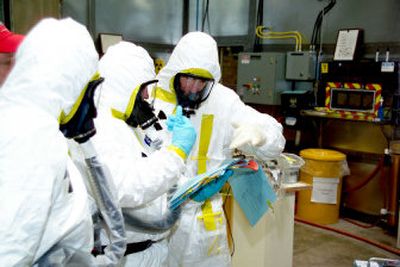Full report on all INL incidents requested

BOISE – When a propane line sprang a leak last month at a federal nuclear research complex in the Idaho desert, hundreds of workers were evacuated and officials made regular announcements on the status of the danger until the problem was fixed hours later.
But dozens of smaller, “near-miss” episodes occur each year without public notification at the Idaho National Laboratory, where the U.S. Department of Energy wants to begin producing plutonium-238 for the first time in decades and where Congress just appropriated $40 million to begin developing an experimental nuclear power reactor.
Instead, details of those minor accidents or procedural oversights are logged in an Energy Department database, the records of which were recently obtained by the Associated Press through the Freedom of Information Act.
In the past year alone, there have been 21 cases of INL workers accidentally contaminated with radioactive material; in all cases, the exposure was classified as negligible. In one case, an employee’s car and home were searched after officials feared europium-154 found on the person’s overcoat had been carried off the high-security nuclear research compound.
In one instance, a few bolts that anchored the seismic braces of a 38-foot-tall heat exchanger in the Advanced Test Reactor to stabilize it during an earthquake were found to have rattled out of their threads. All 180 bolts were found to be too short to properly secure the braces.
And an analysis of the amount of uranium that could safely be stored in a lab failed to take into account that the radioactive material was in powder form, not solid, posing a much higher health risk if spilled than originally estimated.
All of the incidents were minor, and INL officials say none posed a grave risk beyond the boundaries of the 890-square-mile test compound, but they were documented and investigated in an effort to prevent more serious problems.
“The intent of the system is to find, report and fix problems while your problems are small,” said Bob Stallman, senior operations and safety officer at INL. “That’s one of the reasons there are so many reports in the system. Our threshold for reporting is quite low because we want to know the small problems that are occurring.”
But the public has a right to know about all accidents at the site, not just the big ones, say leaders of environmental groups who monitor the remote eastern Idaho facility. The Snake River Alliance, Environmental Defense Institute and Keep Yellowstone Nuclear Free asked the DOE in a Nov. 20 letter to put the “occurrence reports” on the Internet for easy access by the public instead of being released only in response to written requests.
“Right now, the public operates with blinders on and only responds to incidents that the government thinks we need to know about,” said Jeremy Maxand, director of the Snake River Alliance. “If you take one of these incidents and combine it with the right circumstances, you could have a serious situation.”
While the DOE requires written requests from the public to disclose the reports, it sends copies to the state’s Division of INL Oversight and Radiation Control each week. The federal government also notifies the state any time the INL’s radiological assistance team is deployed outside the boundaries of the nuclear reservation.
“We try to strike a balance between the safety of having people well-informed versus having people who might want to do us harm well-informed,” said Kathleen Trever, Gov. Dirk Kempthorne’s coordinator for INL oversight. “As you can imagine, the pendulum at the moment is more on the side of keeping information confidential or less readily available.”